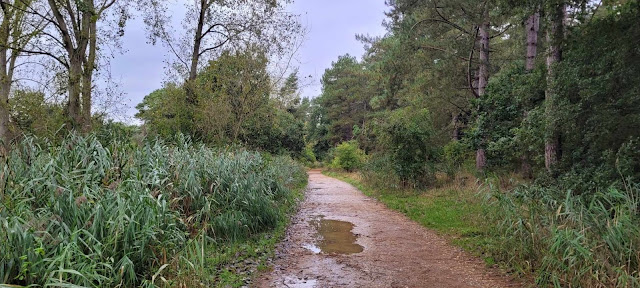It was blowy all night again and it was disappointing to
head out with it still raining after breakfast and once at Holkham we spent a
few minutes waiting for it to pass before gearing up for our day in the field.
It started we with a couple of Song Thrushes dropping in along with the first
calling Redwing of the year and Jays were out burying acorns in the field
margin just beyond the wood affording excellent views and this species became a feature of the day. There were no Pink-feet what so ever.
It was good to get out of the wind and sound of it roaring
through the pines was an accompaniment on the right side for the entire walk
down. We took our time and quickly picked up a Ring Ouzel bounding high ahead
of us followed by a female Brambling that dweeked at us from the top of a dead
tree but other than a few more thrushes it was quieter than I anticipated.
There were Goldcrests and Coal Tits to find and both showed
well but I did not pick up a single warbler until Meals House where a
Chiffchaff was heard while Treecreepers became the bane of my day as we heard
several but did not get a sniff of one of them.
I may have spent some time showing the crew Moth leaf mines – as you do!
 |
| Parornix anglicella on Hawthorn |
 |
| Ectoedemia heringella on Holm Oak |
 |
| Stigmella aurella on Bramble |
.JPG) |
| Phyllonorycter corylifoliella on Hawthorn |
.JPG) |
Stigmella
lemniscella on Elm
|
 |
| Phyllonorycter tristrigella on Elm |
 |
Ruby Tiger cat
|
A Green Woodpecker briefly posed and the lake was home to
the usual happy Mallard, Gadwall and Little Grebes.

A coffee break in the new
shiny Joe Jordan Hide was also quiet with a few Marsh Harriers quartering
including an orange tagged bird and a brief Great White Egret while two Green
Sandpipers were on one of the small pools with some Egyptian Geese. A single flying Pink-foot was the only one we
saw all day. Chinese Water Deer lurked
in the rushes and Swallows drifted east along the tree line.
Outside the Ivy was alive with inverts with Common Wasps and
imposing Hornets, four Hoverfly species, Buff-tailed and Common Carder Bees
and a host of industrious Ivy Bees. Red
Admirals circled and Migrant Hawkers and Common Darters started to get on the
wing too.
 |
| Ivy Bee |
 |
| Hornet |
 |
| Common Darters |
We continued on adding a few flyover Siskins and we could
always hear Robin and Song Thrush but at the end the party of Yellow-browed
Warblers had vacated their Sycamore clump. Looking out over the dunes at the
end there were Swallows and House Martins circulating around the corner where it
met the trees and was obviously concentrating insects and they were joined on
the fence wires by a female Stonechat.
Retracing our steps took us onto the Bluetail Trail and at
the very end of it we at last heard a Yellow-browed Warbler although it moved
away and we didn’t see it. I was very
glad of the Walsey Hill experience yesterday!
Lunch in the hide added a couple of juvenile fly bys and Greenshank and
three Ruff were now on the pools while a male Blackcap was feeding quietly with
a Dunnock in a small Hawthorn. A Lesser Whitethroat was seen briefly by chance being
blown down the hedgeline out onto the marsh with a Chiffchaff!
 |
| Megachile leafcutter bee work - ovals for sides of tubes and circular for lids! |
 |
| Spindle |
 |
| Peltigera lichen |
We spent the amble back trying to pin down those pesky
Treecreepers and Chiffchaffs but failed but there were still birds arriving and
several small groups of Redwing simply dropped out of the sky into the pines.
 |
| Redwings |
 |
| Araneus diadematus |
 |
| Pied Crow - well sort of |
There was time for a coffee at the centre (when a Raven
appeared near some Kites in the distance) and then down to the beach to show the
crew the Bay. The tide was well out but
I could still see Common Scoter so we all enthusiastically yomped off for a
closer look. The wind was howling and
the sand was blowing and everyone was pleased to get a closer view of the
bobbing ducks as well as several sheering juvenile Gannets and briefly a couple
of Sooty Shearwaters.
 |
| Common Gull |
 |
| It was a bit windy |
 |
| Tiny Julie - she did come back... |
 |
| Common Glasswort - Salicornia europea |
It was just too
tough to stand and watch for long so we looped back around and just as we
reached the steps five Wheatear appeared on the tideline. They had not been there when we went out and were
avidly feeding. Such cracking little birds
and with many miles yet to go. A final
Tit-flock check and then back to the van after eight hours in the field.
 |
| Northern Wheatears |
 |
| Northern Wheatear |
 |
| Northern Wheatear |
The journey back to Briarfields was enlivened just before
Burnham Norton with at least eight Cattle Egrets along side the road with time
and space for to stop and have a look from the van. An excellent way to end any day.
 |
| Cattle Egret |



.JPG)
.JPG)

























No comments:
Post a Comment